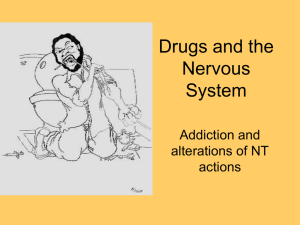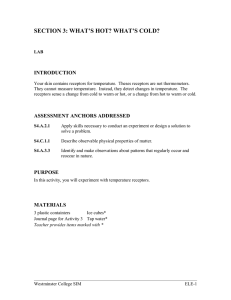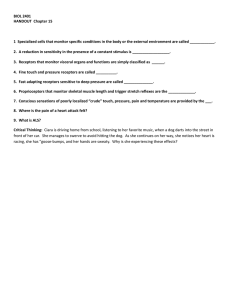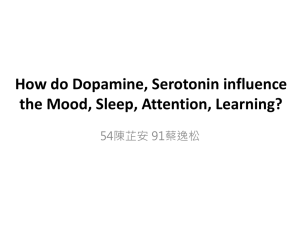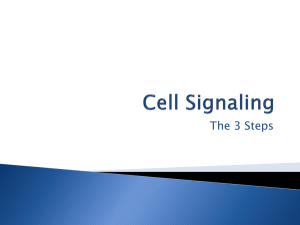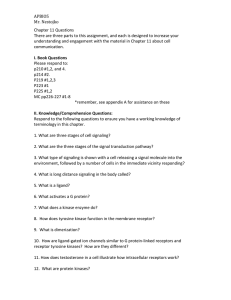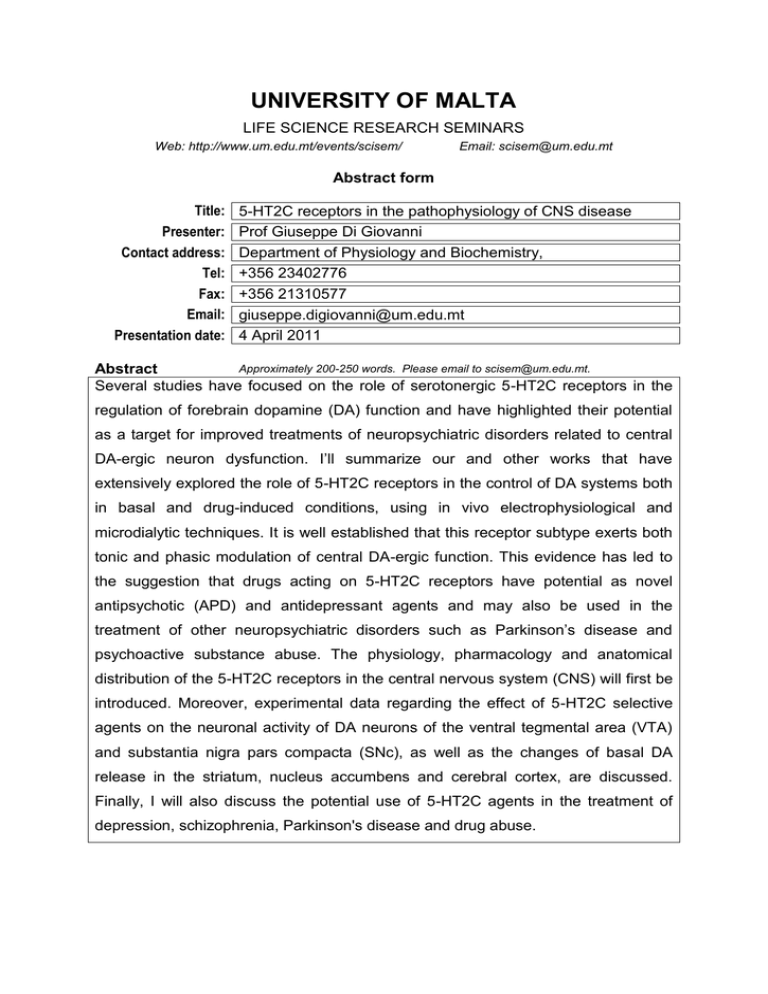
UNIVERSITY OF MALTA
LIFE SCIENCE RESEARCH SEMINARS
Web: http://www.um.edu.mt/events/scisem/
Email: scisem@um.edu.mt
Abstract form
Title:
Presenter:
Contact address:
Tel:
Fax:
Email:
Presentation date:
5-HT2C receptors in the pathophysiology of CNS disease
Prof Giuseppe Di Giovanni
Department of Physiology and Biochemistry,
+356 23402776
+356 21310577
giuseppe.digiovanni@um.edu.mt
4 April 2011
Approximately 200-250 words. Please email to scisem@um.edu.mt.
Abstract
Several studies have focused on the role of serotonergic 5-HT2C receptors in the
regulation of forebrain dopamine (DA) function and have highlighted their potential
as a target for improved treatments of neuropsychiatric disorders related to central
DA-ergic neuron dysfunction. I’ll summarize our and other works that have
extensively explored the role of 5-HT2C receptors in the control of DA systems both
in basal and drug-induced conditions, using in vivo electrophysiological and
microdialytic techniques. It is well established that this receptor subtype exerts both
tonic and phasic modulation of central DA-ergic function. This evidence has led to
the suggestion that drugs acting on 5-HT2C receptors have potential as novel
antipsychotic (APD) and antidepressant agents and may also be used in the
treatment of other neuropsychiatric disorders such as Parkinson’s disease and
psychoactive substance abuse. The physiology, pharmacology and anatomical
distribution of the 5-HT2C receptors in the central nervous system (CNS) will first be
introduced. Moreover, experimental data regarding the effect of 5-HT2C selective
agents on the neuronal activity of DA neurons of the ventral tegmental area (VTA)
and substantia nigra pars compacta (SNc), as well as the changes of basal DA
release in the striatum, nucleus accumbens and cerebral cortex, are discussed.
Finally, I will also discuss the potential use of 5-HT2C agents in the treatment of
depression, schizophrenia, Parkinson's disease and drug abuse.
*LXVHSSH'L*LRYDQQL
Editor-in-Chief
Ennio Esposito
Vincenzo Di Matteo
Assistent Editors
5-HT2C Receptors
in the Pathophysiology
of CNS Disease
635,1*(5
Editors
Editor-in-Chief
Prof. Giuseppe Di Giovanni
University of Malta
Department of Physiology
and Biochemistry
Msida, Malta
giuseppe.digiovanni@um.edu.mt
Assistant Editor
Dr Vincenzo Di Matteo
Consorzio Mario Negri Sud
Centro di Ricerche
Farmacologiche e Biomediche
Chieti, Italy
vdimatteo@negrisud.it
Assistant Editor
Dr Ennio Esposito
Consorzio Mario Negri Sud
Centro di Ricerche
Farmacologiche e Biomediche
Chieti, Italy
esposito@negrisud.it
ISBN 978-1-60761-940-6
e-ISBN 978-1-60761-941-3
DOI 10.1007/978-1-60761-941-3
Springer New York Dordrecht Heidelberg London
© Springer Science+Business Media, LLC 2011
All rights reserved. This work may not be translated or copied in whole or in part without the written
permission of the publisher (Humana Press, c/o Springer Science+Business Media, LLC, 233 Spring
Street, New York, NY 10013, USA), except for brief excerpts in connection with reviews or scholarly
analysis. Use in connection with any form of information storage and retrieval, electronic adaptation,
computer software, or by similar or dissimilar methodology now known or hereafter developed is
forbidden.
The use in this publication of trade names, trademarks, service marks, and similar terms, even if they are
not identified as such, is not to be taken as an expression of opinion as to whether or not they are subject
to proprietary rights.
Printed on acid-free paper
Humana Press is part of Springer Science+Business Media (www.springer.com)
To my wife Samantha,
For her abundant support, for her patience
and understanding, and for her love
G. Di Giovanni
Preface
Accepting the challenge of editing the first book on a subject is a risky business,
particularly if you attempt to produce an overview in the research of 5-HT2C receptors, an area now going back over 25 years with so productive results. Nevertheless,
I have embarked on this unique editorial enterprise with the aim of giving pleasure
to the readers and researchers and not least to myself, confident that it will be
instrumental in future research in 5-HT2C pathophysiology. A few years ago Bryan
Roth edited, for the same series “The Receptors,” a very fine volume on serotonin
receptors. The present volume is a further development of this and is a thorough
examination of the 5-HT2C receptor subclass, needed to cover the extraordinary
amount of research into nearly every aspect of 5-HT2C receptor function that has
recently emerged. This is not surprising, considering that the 5-HT2C receptor is a
prominent central serotonin receptor subtype, widely expressed within the central
and the peripheral nervous system and is thought to play a major role in the regulation of a plethora of behaviors. Therefore, it has been shown by experimental and
clinical observation that it may represent a possible therapeutic target for the development of drugs for a range of CNS disorders such as schizophrenia, depression,
drug abuse, eating disorders, Parkinson’s disease, and epilepsy, to cite but a few.
The book, a result of the efforts of an international group of authors, has the aim of
providing an update of the functional status of the 5-HT2C receptor, covering
molecular, cellular, anatomical, biochemical, and behavioral aspects, to highlight
its distinctive regulatory properties, the emerging functional significance of constitutive activity and RNA-editing in vivo, and the therapeutic potentiality in different
diseases that are singled-out in different chapters.
While covering the latest research, for obvious reasons, this volume cannot be
exhaustive and it has been impossible to include a number of authors of obvious
merit. I hope that more volumes on the subject will be possible in the future.
I want to thank all the authors who have responded very willingly and contributed their time and expertise in preparing their individual contribution to a consistently high standard. My thanks go to Vincenzo Di Matteo and Ennio Esposito who
have contributed to the realization of this book. I am indebted to Philippe De
Deurwaerdère, who has unselfishly dedicated his time and expertise to insightful
and helpful reading of this text and Dr Clare Austen for reviewing the English style
of these manuscripts.
vii
viii
Preface
Finally, I would like to express my sincere appreciation to Kime Neve, series
editor, and Matthew Giampoala, Springer publishing editor, for their help in driving
the book’s development and eventual publication.
I hope that the contents of this volume will further inspire and stimulate discussions and new interdisciplinary research on the 5-HT2C receptor.
May 2010
3URIGiuseppe Di Giovanni
University of Malta
Msida, Malta
Contents
1 The Making of the 5-HT2C Receptor........................................................
Jose M. Palacios, Angel Pazos, and Daniel Hoyer
2 Serotonin 5-HT2C Receptors: Chemical Neuronatomy
in the Mammalian Brain...........................................................................
Guadalupe Mengod
3 The Medicinal Chemistry of 5-HT2C Receptor Ligands..........................
Marcello Leopoldo, Enza Lacivita, Paola De Giorgio,
Francesco Berardi, and Roberto Perrone
4 Insights into 5-HT2C Receptor Function Gained
from Transgenic Mouse Models................................................................
Stephen J. Bonasera
1
17
29
51
5 Serotonin 5-HT2C Receptor Signal Transduction....................................
Maria N. Garnovskaya and John R. Raymond
75
6 Homology Modeling of 5-HT2C Receptors...............................................
Nicolas Renault, Amaury Farce, and Philippe Chavatte
97
7 5-HT2C Receptor Dimerization.................................................................. 129
Katharine Herrick-Davis and Dinah T. Farrington
8 RNA Editing of 5-HT2C Receptor
and Neuropsychiatric Diseases................................................................. 157
Kazuya Iwamoto, Miki Bundo, and Tadafumi Kato
9 Serotonergic Control of Adult Neurogenesis:
Focus on 5-HT2C Receptors....................................................................... 169
Annie Daszuta
ix
x
Contents
10 The Constitutive Activity of 5-HT2C Receptors
as an Additional Modality of Interaction
of the Serotonergic System...................................................................... 187
Sylvia Navailles and Philippe De Deurwaerdère
11 The 5-HT2C Receptor Subtype Controls Central
Dopaminergic Systems: Evidence from
Electrophysiological and Neurochemical Studies................................. 215
Giuseppe Di Giovanni, Ennio Esposito, and Vincenzo
Di Matteo
12 The Role of 5-HT2C Receptors
in the Pathophysiology and Treatment of Depression.......................... 249
Eliyahu Dremencov, Joost H.A. Folgering, Sandra Hogg,
Laurence Tecott, and Thomas I.F.H. Cremers
13 5-HT2C Receptors and Suicidal Behavior............................................... 261
Fabio Panariello, Naima Javaid, and Vincenzo De Luca
14 The 5-HT2C Receptor as a Target for Schizophrenia............................ 275
Herbert Y. Meltzer, Liwen Sun, and Hitoshi Hashimoto
15 Serotonin and Reward-Related Behavior:
Focus on 5-HT2C Receptors..................................................................... 293
Paul J. Fletcher and Guy A. Higgins
16 Tat-3L4F: A Novel Peptide for Treating Drug
Addiction by Disrupting Interaction Between
PTEN and 5-HT2C Receptor.................................................................... 325
Amy Hu, Lintao Jia, Jean-Christian Maillet, and Xia Zhang
17 The Role of Serotonin in Eating Behavior:
Focus on 5-HT2C Receptors..................................................................... 339
Jason C.G. Halford
18 Physiological and Pathophysiological Aspects
of 5-HT2c Receptors in Basal Ganglia..................................................... 351
Philippe De Deurwaerdère, Laurence Mignon,
and Marie-Françoise Chesselet
19 Modeling Tardive Dyskinesia: Predictive
5-HT2C Receptor Antagonist Treatment................................................ 383
Richard M. Kostrzewa
Contents
xi
20 The Role of 5-HT2A/2C Receptors in Sleep and Waking......................... 393
Jaime M. Monti and Héctor Jantos
21 Role of Alternative Splicing of the 5-HT2C
Receptor in the Prader–Willi Syndrome............................................... 413
Shivendra Kishore and Stefan Stamm
22 The Role of 5-HT2C Receptor in Epilepsy.............................................. 429
Rita Jakus and Gyorgy Bagdy
23 The Role of Serotonin on Attentional Processes
and Executive Functioning: Focus on 5-HT2C Receptors..................... 445
Eleftheria Tsaltas and Vasileios Boulougouris
24 5-HT2C Receptors in Learning................................................................ 461
López-Vázquez Miguel Ángel, Gutiérrez-Guzmán Blanca Érika,
Cervantes Miguel, and Olvera-Cortés María Esther
25 The Role of 5-HT2C Polymorphisms in Behavioral
and Psychological Symptoms of Alzheimer Disease............................. 509
Antonia Pritchard
26 Ocular Hypotension: Involvement of Serotonergic 5-HT2 Receptors...... 523
Najam A. Sharif
Index.................................................................................................................. 545

